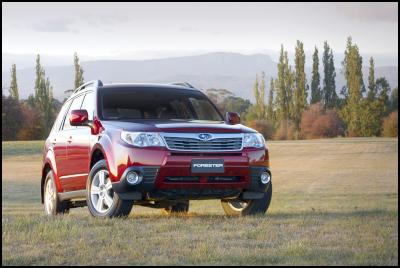Subaru Forester Top Safety Pick
Subaru Forester Top Safety Pick

Click to enlarge
Media
Information
April 22, 2008
Subaru Forester Top
Safety Pick
Subaru’s new Forester is the top safety pick among SUVs (Sports Utility Vehicles) in both New Zealand and the United States.
The third generation Forester has a maximum 5-star occupant protection rating as measured by the independent ANCAP (Australasian New Car Assessment Programme) crash testing. Forester also has a 3-star pedestrian protection (out of a maximum possible 4-stars).
No other SUV of any size on New Zealand’s roads offers a combined eight star ANCAP rating. (See the table below).
And in the United States, the latest Forester has earned the Insurance Institute for Highway Safety's "2008 Top Safety Pick" award.
To win the award, a vehicle must offer superior overall crash protection among those in its class.
It must earn the highest rating of "good" in the Institute's front, side, and rear crash tests, and be equipped with electronic stability control.
"We’re delighted that once again, a Subaru is recognized as a Top Safety Pick", said Tom Doll, executive vice president of Subaru of America.
"This award speaks for the quality work our engineers put into equipping our cars with industry leading safety while still making them affordable with standard All Wheel Drive."
The criteria to win an IIHS award is tough because it is intended to drive continued safety improvements such as crash test ratings and the rapid addition of electronic stability control, which is standard on the Forester.
"The performance of the Forester underscores Subaru's commitment to delivering state-of-the-art safety to its customers," said Mr Doll.
"You don't know what kind of crash you're going to be in. That's why it's important to choose a vehicle that will protect you in all kinds of crashes. The Top Safety Pick designation is intended to help people find the safest choices."
The new Subaru Forester is a total re-design of the award-winning crossover utility vehicle. The latest Forester builds upon its predecessor's reputation as an icon of safety, dependability and versatility.
It projects a bolder design while making a major leap in safety technology, comfort, refinement and driving dynamics.
New Zealand’s Safest SUV’s - ANCAP Safety Ratings
ANCAP SUV Safety Comparison
/ Occupant
Protection Rating / Pedestrian Rating / Total Rating
Make
/ Maximum 5-stars / Maximum 4-stars / Maximum 9-stars
SUBARU FORESTER / 5 / 3 / 8
MITSUBISHI OUTLANDER / 5 /
2 / 7
VOLVO XC90 / 5 / 2 / 7
TOYOTA RAV4 / 4 / 3
/ 7
SUZUKI GRAND VITARA / 4 / 3 / 7
LAND ROVER
FREELANDER / 5 / 1 / 6
VOLKSWAGEN TOUAREG / 5 / 1 /
6
MAZDA CX-7 / 5 / 1 / 6
BMW X5 / 5 / 1 / 6
NISSAN PATHFINDER / 4 / 2 / 6
HONDA CRV / 4 / 2 /
6
HOLDEN CAPTIVA / 4 / 2 / 6
AUDI Q7 / 4 / 2 /
6
NISSAN X-TRAIL / 4 / 2 / 6
SUBARU OUTBACK / 5
/ 0 (Not tested) / 5
SUBARU TRIBECA / 5 / 0 (Not
tested) / 5
All the above SUV's have achieved a minimum of 4-stars for occupant safety and have a total score of 5-stars or greater.
Source: ANCAP Website 7 April 2008 / /
About the IIHS
The Institute's frontal crashworthiness evaluations are based on results of 64 km/h frontal offset crash tests.
Each vehicle's overall evaluation is based on measurements of intrusion into the occupant compartment, injury measures recorded on a Hybrid III dummy in the driver seat, and analysis of slow-motion film to assess how well the restraint system controlled dummy movement during the test.
Side evaluations are based on performance in a crash test in which the side of a vehicle is struck by a barrier moving at 50 km/h.
The barrier represents the front end of a pickup or SUV. Ratings reflect injury measures recorded on two instrumented SID-IIs dummies, assessment of head protection countermeasures, and the vehicle's structural performance during the impact.
Injury measures obtained from the two dummies, one in the driver seat and the other in the back seat behind the driver, are used to determine the likelihood that a driver and/or passenger in a similar real-world crash would sustain serious injury to various parts of the body.
The movements and contacts of the dummies' heads during the test also are evaluated.
Structural performance is based on measurements indicating the amount of B-pillar intrusion into the occupant compartment.
Rear crash protection is rated according to a two-step procedure. Starting points for the ratings are measurements of head restraint geometry - the height of a restraint and its horizontal distance behind the back of the head of an average-size man.
Seats with good or acceptable restraint geometry are tested dynamically using a dummy that measures forces on the neck. This test simulates a collision in which a stationary vehicle is struck in the rear at 32 km/h. Seats without good or acceptable geometry are rated poor overall because they can't be positioned to protect many people.
ENDS


 Harmony Energy: Ceremony Heralds Start Of Construction On New Zealand’s Largest Solar Farm Project
Harmony Energy: Ceremony Heralds Start Of Construction On New Zealand’s Largest Solar Farm Project Stats NZ: Annual Number Of Home Consents Down 7.4 Percent
Stats NZ: Annual Number Of Home Consents Down 7.4 Percent Plains Media: Plains FM Announces Name Change After 37 Years
Plains Media: Plains FM Announces Name Change After 37 Years NIWA: Flooding From Underneath - New Tool Reveals Shallow Groundwater Elevations
NIWA: Flooding From Underneath - New Tool Reveals Shallow Groundwater Elevations Commerce Commission: Commission Concludes Auckland Airport Over-charging By $190 Million
Commerce Commission: Commission Concludes Auckland Airport Over-charging By $190 Million The Future Is Rail: Ferry Decision - Common Sense Prevails
The Future Is Rail: Ferry Decision - Common Sense Prevails



